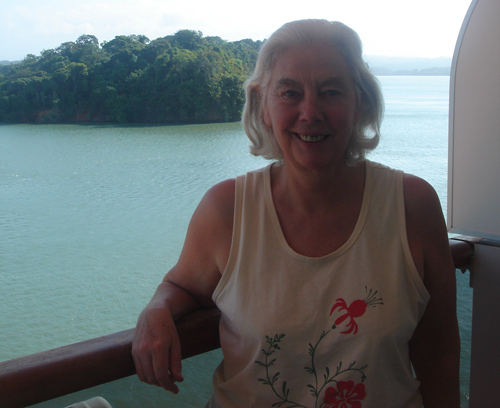We’ve now been at sea for nearly a week. From Miami we took a southerly course past Cuba to Jamaica, then west to Cartagena, Columbia, spending a day in each. On the way, there were sightings of dolphins and flying fish, and the excitement of watching a pod of turtles swim by, the sun reflecting brightly off their heads and shells.
 Cartagena is a smart modern city that is working hard, with apparent success, to overcome its bad reputation for drugs and crime. Education is held in high regard, with sessions of schooling in the morning and afternoon to accommodate all the children and also in the evening for older people who want to make up for what they missed when they were young.
Cartagena is a smart modern city that is working hard, with apparent success, to overcome its bad reputation for drugs and crime. Education is held in high regard, with sessions of schooling in the morning and afternoon to accommodate all the children and also in the evening for older people who want to make up for what they missed when they were young.

Simon Bolivar, who liberated Columbia in 1821, is the national hero and there is a statue of him in the old town, where much of the colonial architecture survives, and most of the old buildings have been well preserved.
From there, accompanied by pelicans and frigate birds, we proceeded to the Panama Canal.
We had looked forward eagerly to this day, and were certainly not disappointed. We rose at 5.30 to be up on deck as we approached the first lock and finally cleared Panama City on the Pacific side at about 4.30pm.  I hope some of you were able to watch our progress and see a few of the views on the web camera. In case you haven’t discovered the webcam, for future reference there’s a link to the appropriate website at the top of this page.
I hope some of you were able to watch our progress and see a few of the views on the web camera. In case you haven’t discovered the webcam, for future reference there’s a link to the appropriate website at the top of this page.
The Canal, finished in 1914, is a huge enterprise that must have transformed international shipping. Mechanical mules on the banks pull the ship through the locks, though when the new, larger locks are completed in a couple of years’ time, tugs will guide the ships through.

It struck me that, apart from finance and politics, which were obviously involved in the endeavour, the project was the child of Vision, Engineering and Poetry. The Vision was perceiving the potential and believing that it could be realised. The Engineering was, in some ways, simple once the vision began to take effect – but took years of very hard work. The Poetry is in the way it works so smoothly, and also in the sheer beauty of parts of the canal – particularly the Gatun Lake which stretches for many miles and is stunning. Not wanting to squeeze too much of a moral out of a highly enjoyable day, I could not help reflecting that for those of us who write, this trio of Vision, Engineering (including hard work) and poetry was familiar territory.
The locks, of course, depend on Lake Gatun’s immense body of fresh water to replenish the supply as water is locked down to the sea. As the rainy season can bring nine feet of water, the system is sustainable as long as climate change doesn’t alter the rain pattern too much. Presumably most of this beautiful lake was formerly rain forest, and the peaks of the hills are now exotic islands, deserted except for the one that houses a Smithsonian biodiversity research station.

As we passed through the canal it was fun to have a huge crocodile to add to our list of wildlife. It must have been at least 14 feet long, and was lazing at the waterside just feet from the boat as we passed. I wouldn’t have been quite so pleased if I’d been walking.
So, passing from NE to SW, we traced the magnificent connection between the Atlantic and Pacific Oceans. As we travel we also connect, fleetingly, with those we pass on the shore or in other boats. We receive enthusiastic waves from people on balconies, workers on the undersides of bridges, passengers in other cruise liners or in passing speedboats.
 And here am I, thousands of miles away,
And here am I, thousands of miles away,
reaching out to connect to those of you at home through this blog.
Next stop Huatulco, Mexico.
3 Comments








